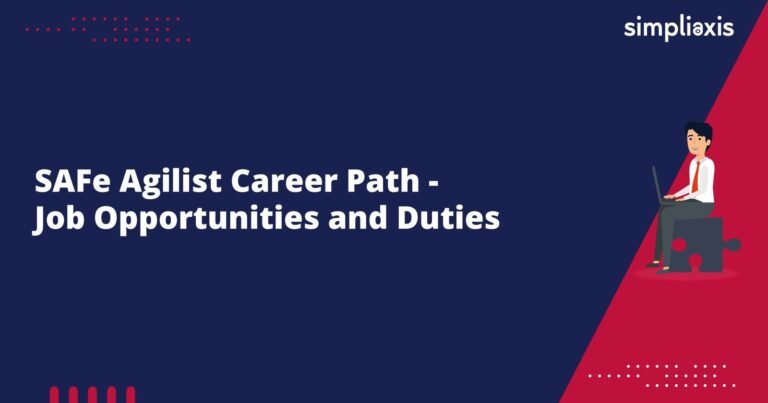The Scaled Agile Framework (SAFe) is a low-level framework that an organization can use to implement and scale Agile techniques in enterprise-level scenarios. The increased SAFe adoption by organizations wanting to work together, deliver fast, and innovate has created a huge demand for certified SAFe Agilists. Different SAFe Agilist jobs offer contributions to organizational agility, each with different responsibilities. In this blog, we will look into the career path of a SAFe Agilist, the roles and responsibilities in the profession, and the skills that help succeed in the respective fields.
Who is a SAFe Agilist?
A SAFe Agilist is a certified professional on SAFe who is capable of leading PI planning events and implementing SAFe at the enterprise level. This certification is awarded to those who successfully complete a Leading SAFe course and exam in which they demonstrate comprehension and the ability to apply Lean-Agile practices to align teams, portfolios, and enterprises with business objectives. They serve as an intermediary between strategy and execution, promoting cross-department collaboration and ensuring that value is delivered.
Based on your mastery of these skills, you can apply for the following roles:
SAFe Agilist certification opens various roles in diverse industries, including IT, finance, healthcare, manufacturing, etc. Here are a few of the more popular SAFe jobs:
- SAFe Practice Consultant (SPC): You are trained to become an SPC, a change agent to educate and coach the organization on SAFe adoption. They are the first to model leadership, launch ARTs, and drive transformation.
- Agile Coach: Agile coaches are professionals who apply their expertise in Agile methods to mentor teams and leaders, with many specializing in SAFe. They lead a culture of continuous improvement, resolve any impediments, and align teams on their SAFe practices.
- Release Train Engineer (RTE): RTEs are servant leaders of the ART, which coordinates many Agile teams to deliver the value. They also help facilitate PI (Program Increment) planning, manage risks, and ensure the smooth delivery of the SAFe processes.
- SAFe Scrum Master: A SAFe Scrum Master guides agile teams within a SAFe environment, ensuring that they adhere to Scrum and SAFe practices. They eliminate obstacles, counsel team members, and foster cooperation.
- Product Owner/Product Manager: Product owner and product manager roles help define and prioritize the work of agile teams in SAFe, ensuring deliverables meet customer needs and align with business goals.
- Manager of Portfolios: SAFe certified professionals apply lean portfolio management principles to ranked investments, budgets, and alignment of initiatives with corporate strategy at the portfolio level.
- Transformation Leads: Responsible for driving Agile adoption across the entire organization by applying SAFe to redesign delivery pipelines, processes, and culture.
Key Duties of a SAFe Agilist
Regardless of the role, SAFe Agilists share core responsibilities that drive Agile success:
- Facilitating SAFe Ceremonies: Agilists schedule and lead PI planning, retrospectives, stand-ups, and system demos for team alignment and transparency.
- Coaching and Training: Train teams, stakeholders, and leadership members on Lean-Agile practices. Typically through formal SAFe corporate training programs.
- Traditional Performance Improvement: Agilists discover bottlenecks and make process improvements by looking at velocity and cycle time metrics.
- Shaping Strategy to Execution: They ensure that efforts at the team level align with and deliver toward portfolio goals, producing measurable business results.
- Managing Dependencies: To keep delivery flowing, agilists manage cross-team dependencies while reducing risks.
- Encouraging Collaboration: By dismantling silos, they establish settings where communication, trust, and common objectives grow.
- Putting Lean Portfolio Management into Practice: Agilists optimize resource allocation at higher levels by matching priorities and budgets with value streams.
Skills for Success
To excel as a SAFe Agilist, you’ll need a blend of technical, interpersonal, and strategic skills:
- Agile expertise: Core knowledge of SAFe, Scrum, Kanban, and Lean concepts is essential.
- Leadership: Servant leadership motivates teams towards accomplishment through influence rather than power.
- Communication: Clearly conveying objectives and feedback ensures alignment among stakeholders.
- Agilists: Agilists are problem solvers of complex issues like process overhead and cultural resistance.
- Adaptability: Navigating challenging environments also requires resilience.
Conclusion
A career as a SAFe Agilist unlocks significant impact roles in a fast-paced domain. You will be able to drive transformations that are value-driven and anchored in excellence by mastering SAFe principles and continuous learning through this course.
